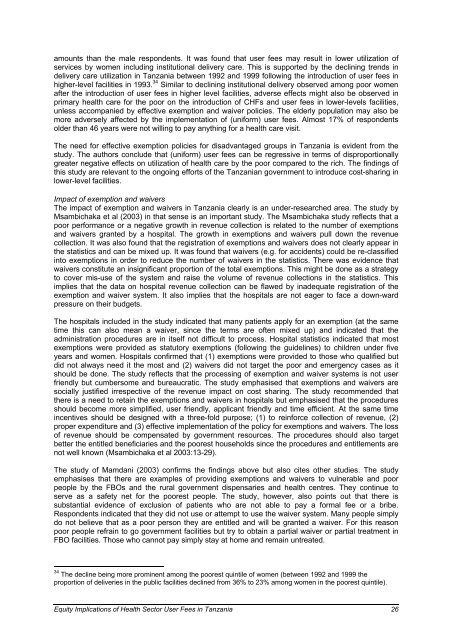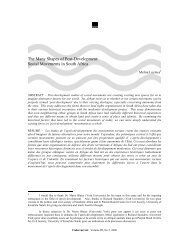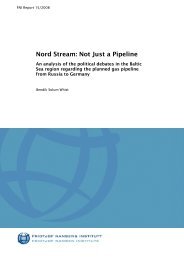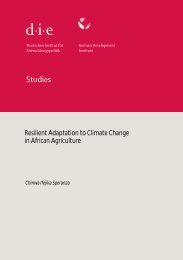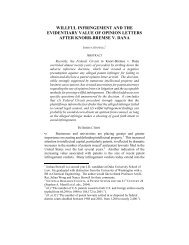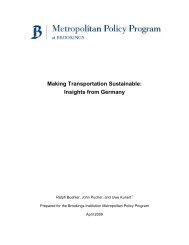equity implications of health sector user fees in tanzania
equity implications of health sector user fees in tanzania
equity implications of health sector user fees in tanzania
Create successful ePaper yourself
Turn your PDF publications into a flip-book with our unique Google optimized e-Paper software.
amounts than the male respondents. It was found that <strong>user</strong> <strong>fees</strong> may result <strong>in</strong> lower utilization <strong>of</strong><br />
services by women <strong>in</strong>clud<strong>in</strong>g <strong>in</strong>stitutional delivery care. This is supported by the decl<strong>in</strong><strong>in</strong>g trends <strong>in</strong><br />
delivery care utilization <strong>in</strong> Tanzania between 1992 and 1999 follow<strong>in</strong>g the <strong>in</strong>troduction <strong>of</strong> <strong>user</strong> <strong>fees</strong> <strong>in</strong><br />
higher-level facilities <strong>in</strong> 1993. 34 Similar to decl<strong>in</strong><strong>in</strong>g <strong>in</strong>stitutional delivery observed among poor women<br />
after the <strong>in</strong>troduction <strong>of</strong> <strong>user</strong> <strong>fees</strong> <strong>in</strong> higher level facilities, adverse effects might also be observed <strong>in</strong><br />
primary <strong>health</strong> care for the poor on the <strong>in</strong>troduction <strong>of</strong> CHFs and <strong>user</strong> <strong>fees</strong> <strong>in</strong> lower-levels facilities,<br />
unless accompanied by effective exemption and waiver policies. The elderly population may also be<br />
more adversely affected by the implementation <strong>of</strong> (uniform) <strong>user</strong> <strong>fees</strong>. Almost 17% <strong>of</strong> respondents<br />
older than 46 years were not will<strong>in</strong>g to pay anyth<strong>in</strong>g for a <strong>health</strong> care visit.<br />
The need for effective exemption policies for disadvantaged groups <strong>in</strong> Tanzania is evident from the<br />
study. The authors conclude that (uniform) <strong>user</strong> <strong>fees</strong> can be regressive <strong>in</strong> terms <strong>of</strong> disproportionally<br />
greater negative effects on utilization <strong>of</strong> <strong>health</strong> care by the poor compared to the rich. The f<strong>in</strong>d<strong>in</strong>gs <strong>of</strong><br />
this study are relevant to the ongo<strong>in</strong>g efforts <strong>of</strong> the Tanzanian government to <strong>in</strong>troduce cost-shar<strong>in</strong>g <strong>in</strong><br />
lower-level facilities.<br />
Impact <strong>of</strong> exemption and waivers<br />
The impact <strong>of</strong> exemption and waivers <strong>in</strong> Tanzania clearly is an under-researched area. The study by<br />
Msambichaka et al (2003) <strong>in</strong> that sense is an important study. The Msambichaka study reflects that a<br />
poor performance or a negative growth <strong>in</strong> revenue collection is related to the number <strong>of</strong> exemptions<br />
and waivers granted by a hospital. The growth <strong>in</strong> exemptions and waivers pull down the revenue<br />
collection. It was also found that the registration <strong>of</strong> exemptions and waivers does not clearly appear <strong>in</strong><br />
the statistics and can be mixed up. It was found that waivers (e.g. for accidents) could be re-classified<br />
<strong>in</strong>to exemptions <strong>in</strong> order to reduce the number <strong>of</strong> waivers <strong>in</strong> the statistics. There was evidence that<br />
waivers constitute an <strong>in</strong>significant proportion <strong>of</strong> the total exemptions. This might be done as a strategy<br />
to cover mis-use <strong>of</strong> the system and raise the volume <strong>of</strong> revenue collections <strong>in</strong> the statistics. This<br />
implies that the data on hospital revenue collection can be flawed by <strong>in</strong>adequate registration <strong>of</strong> the<br />
exemption and waiver system. It also implies that the hospitals are not eager to face a down-ward<br />
pressure on their budgets.<br />
The hospitals <strong>in</strong>cluded <strong>in</strong> the study <strong>in</strong>dicated that many patients apply for an exemption (at the same<br />
time this can also mean a waiver, s<strong>in</strong>ce the terms are <strong>of</strong>ten mixed up) and <strong>in</strong>dicated that the<br />
adm<strong>in</strong>istration procedures are <strong>in</strong> itself not difficult to process. Hospital statistics <strong>in</strong>dicated that most<br />
exemptions were provided as statutory exemptions (follow<strong>in</strong>g the guidel<strong>in</strong>es) to children under five<br />
years and women. Hospitals confirmed that (1) exemptions were provided to those who qualified but<br />
did not always need it the most and (2) waivers did not target the poor and emergency cases as it<br />
should be done. The study reflects that the process<strong>in</strong>g <strong>of</strong> exemption and waiver systems is not <strong>user</strong><br />
friendly but cumbersome and bureaucratic. The study emphasised that exemptions and waivers are<br />
socially justified irrespective <strong>of</strong> the revenue impact on cost shar<strong>in</strong>g. The study recommended that<br />
there is a need to reta<strong>in</strong> the exemptions and waivers <strong>in</strong> hospitals but emphasised that the procedures<br />
should become more simplified, <strong>user</strong> friendly, applicant friendly and time efficient. At the same time<br />
<strong>in</strong>centives should be designed with a three-fold purpose; (1) to re<strong>in</strong>force collection <strong>of</strong> revenue, (2)<br />
proper expenditure and (3) effective implementation <strong>of</strong> the policy for exemptions and waivers. The loss<br />
<strong>of</strong> revenue should be compensated by government resources. The procedures should also target<br />
better the entitled beneficiaries and the poorest households s<strong>in</strong>ce the procedures and entitlements are<br />
not well known (Msambichaka et al 2003:13-29).<br />
The study <strong>of</strong> Mamdani (2003) confirms the f<strong>in</strong>d<strong>in</strong>gs above but also cites other studies. The study<br />
emphasises that there are examples <strong>of</strong> provid<strong>in</strong>g exemptions and waivers to vulnerable and poor<br />
people by the FBOs and the rural government dispensaries and <strong>health</strong> centres. They cont<strong>in</strong>ue to<br />
serve as a safety net for the poorest people. The study, however, also po<strong>in</strong>ts out that there is<br />
substantial evidence <strong>of</strong> exclusion <strong>of</strong> patients who are not able to pay a formal fee or a bribe.<br />
Respondents <strong>in</strong>dicated that they did not use or attempt to use the waiver system. Many people simply<br />
do not believe that as a poor person they are entitled and will be granted a waiver. For this reason<br />
poor people refra<strong>in</strong> to go government facilities but try to obta<strong>in</strong> a partial waiver or partial treatment <strong>in</strong><br />
FBO facilities. Those who cannot pay simply stay at home and rema<strong>in</strong> untreated.<br />
34 The decl<strong>in</strong>e be<strong>in</strong>g more prom<strong>in</strong>ent among the poorest qu<strong>in</strong>tile <strong>of</strong> women (between 1992 and 1999 the<br />
proportion <strong>of</strong> deliveries <strong>in</strong> the public facilities decl<strong>in</strong>ed from 36% to 23% among women <strong>in</strong> the poorest qu<strong>in</strong>tile).<br />
Equity Implications <strong>of</strong> Health Sector User Fees <strong>in</strong> Tanzania 26


